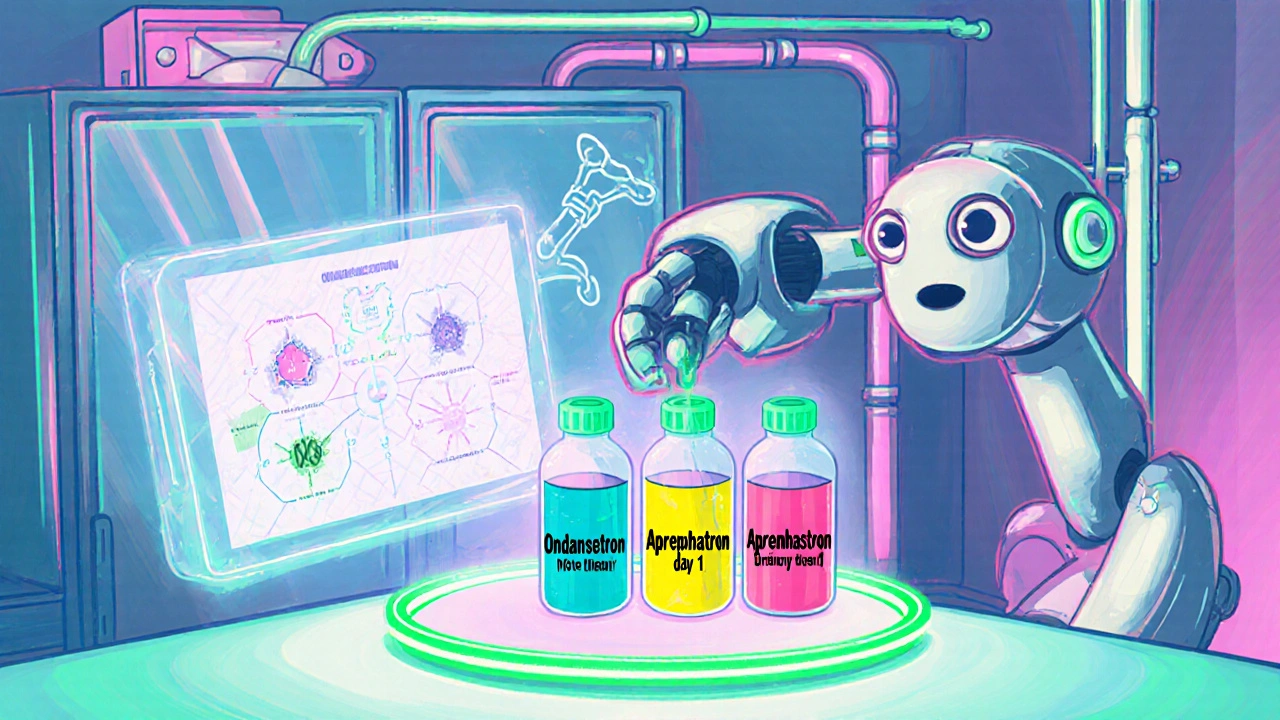Pre‑Medication Guide: Antiemetics, Antihistamines & Steroids for Safe Procedures

Pre‑Medication Timing Calculator
Procedure Timing Setup
When you walk into a radiology suite or an oncology infusion center, the last thing you want is a sudden reaction that derails the whole appointment. That’s why clinicians rely on pre‑medication protocols that line up anti‑emetics, antihistamines, and steroids before the needle even touches the skin. This guide breaks down the why, how, and when of each drug class, gives you a quick‑look comparison table, and offers real‑world tips to keep the process smooth for patients and staff.
Why Pre‑Medication Matters
Adverse reactions to contrast media or chemotherapy range from mild nausea to life‑threatening anaphylaxis. Studies from the American College of Radiology (ACR) show that targeted pre‑medication drops moderate‑to‑severe contrast reactions from 0.2‑0.7% down to 0.04% for high‑risk patients. In the oncology world, the ASCO Antiemesis Guidelines report a 70‑80% complete response rate when a three‑drug anti‑emetic regimen is used, compared with roughly 50% when only a single agent is given. The common thread? Timely, evidence‑based drug combinations can prevent the bulk of these events while keeping patients comfortable.
Antiemetics: Controlling Nausea Before It Starts
Antiemetics target the neural pathways that trigger nausea and vomiting. The most effective modern regimen pairs a 5‑HT3 receptor antagonist (like ondansetron) with an NK1 antagonist (aprepitant or its newer version fosnetupitant) and a steroid such as dexamethasone. A 2023 meta‑analysis in the Journal of Clinical Oncology found that this triple therapy cut chemotherapy‑induced nausea and vomiting (CINV) incidence to 28.4%, versus 56.7% with dual therapy alone.
Typical dosing for an adult receiving highly emetogenic chemotherapy looks like this:
- Ondansetron 8 mg IV push 30 minutes before chemo.
- Aprepitant 125 mg oral on day 1, then 80 mg on days 2‑3.
- Dexamethasone 12 mg IV on day 1, then 8 mg PO daily for the next two days.
For moderate‑risk regimens, a simplified two‑drug combo (ondansetron + dexamethasone) still offers >70% protection, but the addition of an NK1 blocker becomes essential when the emetogenic potential climbs above 90% (e.g., cisplatin).
Antihistamines: Blunting Allergic Reactions
Antihistamines block H1 receptors, reducing histamine‑driven symptoms like itching, urticaria, and bronchospasm. Second‑generation agents such as cetirizine are now preferred over diphenhydramine because they cause far less drowsiness-15.3% versus 42.7% incidence according to a 2021 JAMA Internal Medicine study-while maintaining comparable efficacy for preventing hypersensitivity reactions (HSRs) to contrast media.
Yale Medicine’s outpatient protocol for patients with a prior contrast reaction recommends:
- Prednisone 50 mg orally at -13 hours, -7 hours, and -1 hour before contrast injection.
- Cetirizine 10 mg PO within 1 hour of the contrast dose.
In the emergency department or inpatient setting where IV access is already in place, the protocol swaps oral prednisone for IV methylprednisolone (40 mg) given 4 hours before the contrast, paired with either IV diphenhydramine 50 mg or oral cetirizine 10 mg within the hour prior to imaging.
Pediatric dosing follows weight‑based calculations: prednisolone or prednisone 0.7 mg/kg (max 50 mg) at the same three‑time points, and cetirizine for children >6 months (5 mg for 6‑12 months, then 10 mg for >12 months). Infants under 6 months receive diphenhydramine 1 mg/kg (max 50 mg) IV.
Steroids: The Timing Game
Steroids blunt the immune cascade that leads to both HSRs and delayed nausea. Oral prednisone needs a 13‑hour lead time to reach peak anti‑inflammatory effect, making it ideal for scheduled outpatient studies. In contrast, IV methylprednisolone peaks in about 4 hours, allowing same‑day pre‑medication for inpatient or emergency cases.
Typical adult dosing schedules:
- Oral prednisone 50 mg at -13 h, -7 h, and -1 h (outpatient contrast).
- IV methylprednisolone 40 mg at -4 h (in‑patient contrast).
- IV hydrocortisone 200 mg as an alternative when methylprednisolone is unavailable.
Adverse effects-hyperglycemia, insomnia, mood swings-are usually mild for a short three‑dose course, but clinicians still screen diabetic patients and monitor blood glucose when a steroid is part of the regimen.

Quick Comparison of Drug Classes
| Drug class | Primary purpose | Typical route | Onset (approx.) | Common side‑effects |
|---|---|---|---|---|
| Antiemetics (5‑HT3 + NK1 + dexamethasone) | Prevent CINV | IV & oral | 5‑30 min | Headache, constipation, mild hyperglycemia |
| Antihistamines (cetirizine, diphenhydramine) | Block H1‑mediated HSRs | PO or IV | 30‑60 min | Drowsiness (more with diphenhydramine), dry mouth |
| Steroids (prednisone, methylprednisolone) | Suppress immune cascade, reduce inflammation | PO or IV | 4‑13 h depending on route | Hyperglycemia, insomnia, mood changes |
Step‑by‑Step Implementation Checklist
- Identify high‑risk patients: prior contrast reaction, high‑emetic chemotherapy, known allergy to iodine or gadolinium.
- Calculate weight‑based doses for pediatrics and adjust for renal/hepatic function.
- Enter orders into the EHR using a standardized pre‑medication order set (many systems now have built‑in alerts for the 13‑hour steroid window).
- Verify timing: set pharmacy reminders for oral prednisone at -13 h and -7 h, or schedule IV methylprednisolone 4 h before the procedure.
- Label all prepared syringes with patient name, drug, dose, and administration time per ISMP Best Practice 15.
- Perform a double‑check at bedside: nurse, pharmacist, and ordering physician sign‑off.
- Document administration in the procedure note and flag any breakthrough reaction for quality‑improvement review.
Common Pitfalls & Pro Tips
Pitfall: Forgetting the 13‑hour prednisone window and ending up with same‑day oral dosing.
Pro tip: Use automated pharmacy alerts or patient‑facing text reminders that fire 14 hours before the scheduled study.
Pitfall: Mixing first‑generation antihistamines in low‑risk patients and causing unnecessary sedation.
Pro tip: Adopt a “second‑generation‑first” policy; reserve diphenhydramine for infants <6 months or when an IV route is mandatory.
Pitfall: Over‑looking steroid‑induced hyperglycemia in diabetics.
Pro tip: Order a point‑of‑care glucose check 2 hours after steroid administration and adjust insulin per protocol.

Monitoring Outcomes and Continuous Improvement
After implementing any pre‑medication protocol, track three core metrics for at least six months:
- Reaction rate: Percentage of patients experiencing any HSR or CINV.
- Protocol adherence: How often all three drug classes were given at the correct times.
- Medication error rate: Incidents of wrong dose, wrong timing, or labeling mistakes.
Facilities that added barcode‑assisted medication administration (BAMA) saw a 38% drop in pre‑medication errors (Johns Hopkins, 2023). When the data show a lingering 0.8% moderate reaction rate, consider adding a low‑dose antihistamine booster within 30 minutes of the procedure as a rescue step.
Future Directions
Artificial‑intelligence risk models are already predicting contrast reactions with >80% accuracy (Ye et al., 2023). Integrating these scores into the EHR could auto‑populate the optimal pre‑medication regimen, sparing clinicians from manual risk calculations. Meanwhile, next‑generation NK1 agents like fosnetupitant are moving into guideline updates, promising even higher CINV control with fewer drug‑drug interactions.
Bottom Line
Effective pre‑medication isn’t a one‑size‑fits‑all checklist; it’s a patient‑specific bundle of anti‑emetics, antihistamines, and steroids timed to hit the right therapeutic window. By following evidence‑based dosing, using EHR alerts, and monitoring outcomes, you’ll keep reaction rates low, improve patient comfort, and meet safety standards set by the ACR, ISMP, and ASCO.
Do I need to give all three drug classes to every patient?
Only patients at documented risk-previous contrast reaction, high‑emetic chemotherapy, or known allergy-should receive the full combo. Low‑risk patients may get a single agent or none, per ACR guidance.
What’s the fastest way to get steroid coverage for an emergency scan?
Use IV methylprednisolone 40 mg given at least 4 hours before contrast. This bypasses the 13‑hour oral prednisone lag.
Are second‑generation antihistamines safe for children?
Yes. Cetirizine can be given to kids older than 6 months-with dosing based on weight. For infants under 6 months, diphenhydramine remains the recommended IV option.
How do I prevent steroid‑induced hyperglycemia?
Check glucose 2 hours after the steroid dose, adjust insulin as per your hospital’s diabetic protocol, and consider a lower steroid dose if the patient’s baseline A1C is high.
Can I skip the antihistamine if the patient has no allergy history?
If the patient’s risk assessment shows no prior HSR, you may omit the antihistamine. However, many centers still add a low‑dose cetirizine because the benefit-to‑risk ratio is very favorable.

Nathan Comstock
October 25, 2025 AT 13:28Look, if you’re still wondering why we bother with this pre‑med cocktail, the answer is simple: it saves lives and keeps the whole system from grinding to a halt. The data from ACR and ASCO aren’t just academic fluff; they’re hard‑won evidence that cuts reaction rates by an order of magnitude. Skipping the 13‑hour steroid window because you’re “in a hurry” is a rookie mistake that could land you in legal trouble. I’ve seen departments grind to a halt after a single anaphylactic event – don’t be that department.
Jennifer Stubbs
November 11, 2025 AT 05:28While the stakes are undeniably high, the guide could have highlighted the cost‑benefit analysis of adding a third anti‑emetic in moderate‑risk patients. Not every facility has the budget for NK1 blockers, and the incremental gain drops off sharply after the first two agents. A nuanced algorithm would help clinicians avoid overtreatment while still protecting the vulnerable.
Abhinav B.
November 27, 2025 AT 21:28Yo bro, thsi pre‑med thingy is crutial, but u gotta remeber the timiing is key. If you give prednison too late, the anti‑inflammtory effect wont kick in. Also, dont forget to double check weight‑based dosing for kids – i seen a lot of miscalc, especially with 0.7 mg/kg rule. The guide is good but needs more pics for the dosing steps.